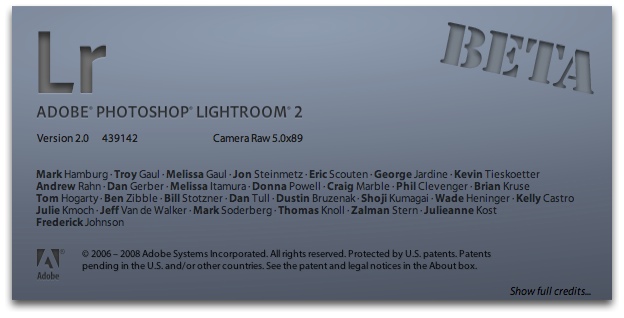
Hot on the heels of Apple’s release of Aperture 2.1, Adobe let Lightroom 2.0 loose on April 1st. Though the specs will undoubtedly change before release, the current build adds some features that Aperture has had for a while, while simultaneously adding some that move LR2 ahead of Apple in some aspects.
To get a feel for all the features I recommend you download and play with the beta, but some of the most showcased additions include:
- New retouching tool
- Smart Collections
- Multiple monitor support
- 64 bit support
- Panorama stitching
- Importing multiple exposures into CS3 as HDR
The retouching tool integrates dodging/burning into the Lightroom workflow in a completely non-destructive manner (Aperture creates an intermediate TIFF file for its plug-ins). This keeps the changes editable throughout all combinations of editing steps. For people that often like to tweak things, this will be a huge timesaver.
Smart Collections are dynamically generated based on certain keywords or other metadata. I have used this feature in Aperture since its inception and its power can not be understated. By setting up a smart collection named Portfolio that searches for the keyword “portfolio” I simply tag images I like with the keyword. The next time I click on the Portfolio collection all the images show up. It really removes a lot of micro management from the process of keeping track of your images. I hope that Adobe also implements smart web galleries to make the whole process seamless.
A huge new addition is multiple monitor support. Being able to view a full-screen image on one screen and the thumbnails on a second is a no-compromise solution to editing. On a screen with enough resolution the loupe tool is barely used and the editing process becomes much more fluid with that step removed. I always wondered why this never made it into LR1, Adobe of all companies should understand the benefits of multiple screens.
64 bit support is a welcome addition, but mostly because it future-proofs the codebase, not for any performance reasons. Right now, the only significant performance boost a 64 bit platform delivers is in the processing of HUGE datasets that benefit from more than 4GB of RAM that 32 bit processes are limited to. In other words, if you are not working with 3.75 gigapixel images, you have about an 8-12% increase in performance to look forward to. Nothing to write home about, really.
What I don’t understand is the addition of anemic HDR support and the panorama stitching. The HDR support in CS3 is already pretty weak, and LR2′s only claim to fame in this area is that it can pass multiple exposures to CS3 for the actual making of the HDR. Why this is even listed as a feature is beyond me. Same with the panorama stitching. I can only imagine Adobe’s trying to woo the “prosumer” crowd to expand the user base of the product. I think there are more important things to be focusing on, but I don’t work there.
One interesting tidbit is the SDK. It is in the user’s best interest to keep everything non-destructive, and Adobe is trying to figure out how to enable third-party plug-ins without destroying that metadata workflow. Apple on the other hand decided to do a cross between non-destructive and destructive by implementing the generation of an intermediate TIFF. Both have their pros and cons, but ultimately non-destructive is the way to go and I hope Adobe figures it out to put a flame under Apple in that regard.
In the end this another great release to put pressure on Apple and make the lives of LR1 users easier.


Leave a Reply